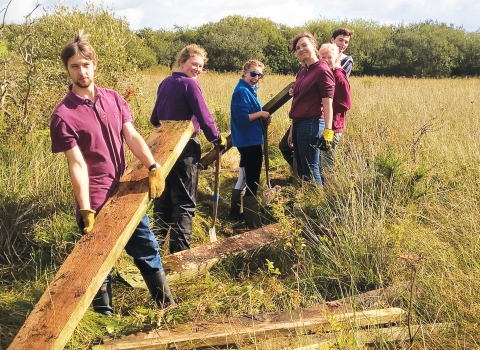
Barn Owl _Andy Rouse 2020VISION

Grasshopper warbler © Richard Steel2020VISION

Cors Goch Nature Reserve © Damien Hughes

Cors Coch Nature Reserve volunteers

Green-winged orchid - Gwent Wildlife Trust

Small Pearl bordered Fritillary © Chris Lawrence
Cors Goch Nature Reserve
Know before you go
Dogs
When to visit
Opening times
Open at all timesBest time to visit
From May and through the summer is the best time for wildflowers, birds and insects. But a visit at any time of the year will provide the opportunity for some interesting wildlife encounters.About the reserve
Situated in a shallow valley and fed by lime-rich water, Cors Goch reflects a long history of human activity. Used by the local community for centuries, it’s a place where cattle grazed, reeds were cut and stone was quarried to make millstones. Today, the complex geology and wealth of habitats make it one of Wales’s most diverse, colourful nature reserves: part of an internationally significant network of fens in Anglesey.
The higher ground of the reserve is made up of coarse, acidic sandstone and more alkaline limestone – you can find examples of these rocks in the many dry-stone walls around the nature reserve. The connection between rock, soil and plants is clearly visible at the surface: enjoy the brightly coloured heather and gorse and the scarce pale dog-violet and marsh gentian that thrive in the acid heathlands or, through the summer months, discover the wide range of amazing orchids that can be found associated with the limestone areas.
At lower levels, Cors Goch’s wetlands are home to many other rare plants, including insectivorous species, and their own collection of orchids. Here, a walk in spring is accompanied by the songs of grasshopper warbler, sedge warbler and reed bunting, attracted to the extensive wetlands for nesting. Dragonflies and damselflies can be seen from the boardwalk – flashes of colour darting above the wet ground beneath.
Cors Goch is worth a visit at any time of year. Be sure to give yourself a few hours to explore the whole of this large, vibrant site – and appreciate its deep sense of belonging in the landscape.
Grazing for wildlife
Around Cors Goch, many of the plants and animals require open conditions to be able to survive, to feed or flower, or to have young. To help achieve this, ponies and cattle graze the reserve year-round. By treading the wetland peat, the animals create small pools, useful for dragonflies, and freshwater plants; whilst carefully controlled grazing levels on the heathland and grassland allow plants such as adder’s-tongue fern and green-winged orchid to flourish. NWWT staff and volunteers work alongside the grazing regime to manage scrub, bramble and bracken; helping to create a diverse range of habitats throughout the reserve.
In contrast, Cors Goch’s broad hedgerows and woodland are protected from grazing and managed to provide shelter and food for a wide range of birds and mammals. They provide important corridors linking the nature reserve to the surrounding landscape.
Did you know?
Some of the peat deposits here are up to over 10 metres deep. This indicates that the fen on this reserve has been developing for over 12,000 years!
Directions
Follow the A5025 from Pentraeth for about 1.5 miles until you reach a junction, turning Left towards Llanbedrgoch. About 1 mile beyond Llanbedrgoch there’s a signpost for the reserve, and a lay-by on the Left where you can park (SH 504 816). There’s space for 2-3 cars to park here. Follow the track from the lay-by to the reserve.
Other access routes and parking are also available.






